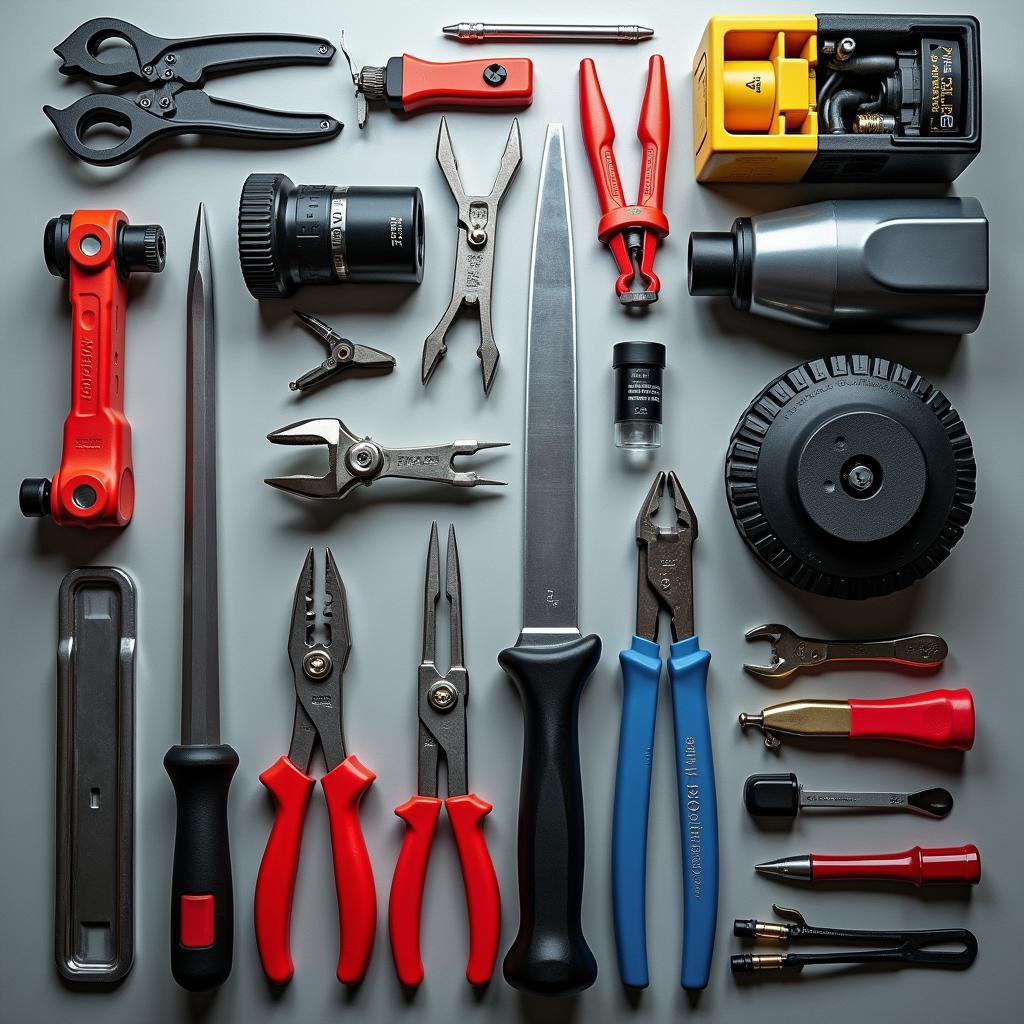Servicing your car regularly is crucial for its longevity, performance, and your safety on the road. While taking your car to a professional mechanic is always recommended, understanding the basics of car servicing can empower you to handle minor maintenance tasks yourself or at least be informed when discussing your car’s needs with a mechanic. This comprehensive guide will walk you through the essential steps on how to service a car, providing valuable insights and practical tips along the way.
Essential Tools and Materials
Before diving into the step-by-step process, let’s gather the necessary tools and materials you’ll need:
- Wrench Set: A good-quality wrench set is essential for loosening and tightening nuts and bolts.
- Socket Set: Socket sets come in handy for various tasks, including removing spark plugs and other components.
- Screwdrivers: Have both flat-head and Phillips-head screwdrivers in various sizes.
- Oil Filter Wrench: This specialized wrench helps remove the oil filter without causing damage.
- Funnel: A funnel makes pouring fluids easier and prevents spills.
- Gloves: Protect your hands from dirt, grease, and hot fluids with a pair of durable gloves.
- Jack and Jack Stands: These tools are crucial for safely lifting and securing the car.
- Drainage Pan: Use a drainage pan to collect used oil and other fluids.
- Shop Rags: Keep a stack of clean rags nearby to wipe away spills and clean parts.
- Replacement Parts: This includes engine oil, oil filter, air filter, spark plugs (if needed), and any other components you plan to replace.
 Car Service Tools
Car Service Tools
Step 1: Consult Your Owner’s Manual
Before you begin, it’s crucial to consult your car’s owner’s manual. This document is a treasure trove of information specific to your vehicle model, including recommended service intervals, fluid types, and other essential details. Familiarize yourself with the manufacturer’s recommendations to ensure you’re performing the correct service procedures for your car.
Step 2: Find a Safe and Level Work Area
Safety should always be your top priority. Choose a well-ventilated and level surface to work on. If you’re working in a garage, ensure the door is open for proper ventilation. Never work under a car that is solely supported by a jack; always use jack stands for safety.
Step 3: Begin with an Oil Change
An oil change is one of the most fundamental car maintenance tasks. Here’s how to do it:
-
Warm up the engine: Drive your car for a few minutes to warm up the engine oil, which will make it drain more easily.
-
Position the drainage pan: Place the drainage pan under the engine oil drain plug, located on the oil pan beneath the engine.
-
Remove the drain plug: Use a wrench to loosen and remove the drain plug, allowing the oil to drain completely.
-
Replace the drain plug: Once the oil has drained, clean the drain plug and install a new crush washer before tightening it securely.
-
Remove and replace the oil filter: Locate the oil filter, typically on the side of the engine. Use an oil filter wrench to loosen and remove the old filter. Before installing the new filter, lubricate the gasket with a small amount of fresh engine oil.
-
Add new engine oil: Consult your owner’s manual for the correct type and amount of engine oil. Use a funnel to pour the new oil into the engine oil fill hole, located on the top of the engine.
-
Check the oil level: Start the engine and let it run for a minute to circulate the oil. Turn off the engine and check the oil level using the dipstick. Add more oil if necessary to reach the appropriate level.
Step 4: Replace the Air Filter
The air filter prevents dirt and debris from entering the engine. Replacing it is a simple task:
- Locate the air filter housing: Refer to your owner’s manual if you’re unsure where the air filter housing is located. It’s typically a rectangular box with clips or screws.
- Open the housing and remove the old filter: Open the air filter housing and carefully remove the old air filter. Note the position of the filter for correct installation of the new one.
- Insert the new air filter: Place the new air filter in the housing, ensuring it’s seated correctly.
- Close the air filter housing: Securely close the air filter housing, making sure all clips or screws are properly fastened.
Step 5: Inspect Other Fluids and Components
While performing an oil change and replacing the air filter are excellent starting points, take the opportunity to inspect other essential fluids and components:
-
Coolant: Check the coolant level and condition. If it’s low or discolored, it might be time for a flush and refill.
-
Brake Fluid: Ensure the brake fluid level is within the recommended range and that the fluid is clear.
-
Power Steering Fluid: Inspect the power steering fluid level and look for any leaks in the system.
-
Belts and Hoses: Examine belts and hoses for signs of wear and tear, such as cracks, fraying, or looseness.
-
Lights: Test all exterior lights, including headlights, taillights, brake lights, and turn signals, to ensure they are functioning correctly.
-
Tires: Check tire pressure using a tire pressure gauge and inflate or deflate as needed. Inspect tire tread depth and look for any signs of damage or uneven wear.
Step 6: Wrap Up and Seek Professional Help When Needed
Once you’ve completed these steps, give your car a final check and dispose of used fluids and old parts responsibly. Remember that this guide provides a basic overview of car servicing, and some tasks, such as brake inspections or spark plug replacements, may require specialized tools, knowledge, and experience. If you encounter any issues or feel uncomfortable performing certain procedures, it’s always best to err on the side of caution and seek assistance from a qualified mechanic.
Conclusion
Regular car servicing is essential for maintaining your vehicle’s performance, reliability, and safety. By following these step-by-step instructions and adhering to the manufacturer’s recommendations in your owner’s manual, you can take proactive steps to keep your car running smoothly for years to come. Remember, while this guide empowers you with basic car maintenance knowledge, don’t hesitate to seek professional help from a trusted mechanic when needed.
FAQ
Q1: How often should I service my car?
A: Refer to your owner’s manual for the recommended service intervals specific to your car model. Generally, it’s a good idea to service your car at least once a year or every 10,000 – 12,000 miles, whichever comes first.
Q2: Can I use any type of engine oil for my car?
A: No, using the correct type of engine oil for your car is crucial. Consult your owner’s manual to determine the recommended oil viscosity and specifications.
Q3: What should I do if I see a fluid leak under my car?
A: Fluid leaks can indicate a serious problem. It’s best to avoid driving your car and contact a qualified mechanic immediately to diagnose and repair the issue.
Q4: How do I know if my car needs new brake pads?
A: If you hear a squealing or grinding noise when braking, or if your car pulls to one side when braking, it’s essential to have your brake pads inspected and replaced if necessary.
Q5: Is it necessary to replace the air filter regularly?
A: Yes, a clogged air filter can restrict airflow to the engine, reducing performance and fuel efficiency. Replacing the air filter regularly as recommended in your owner’s manual is essential.
Do you have other questions about your car service? Check out how to get service history of a car in kerala or does car service include wheel alignment. You can also find more useful articles on our website.
Need further assistance? Our team is ready to help you 24/7. Contact us via WhatsApp: +1(641)206-8880, or Email: [email protected].

